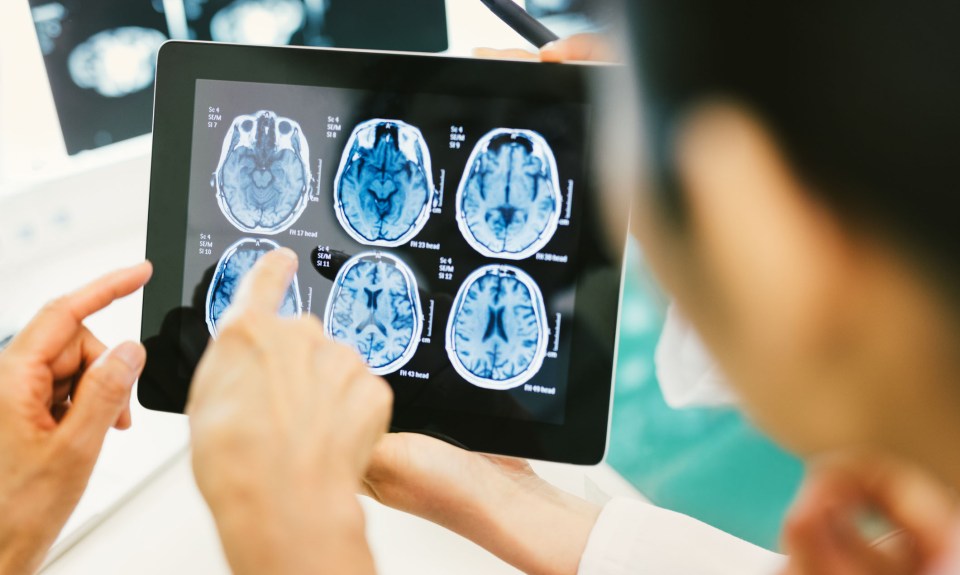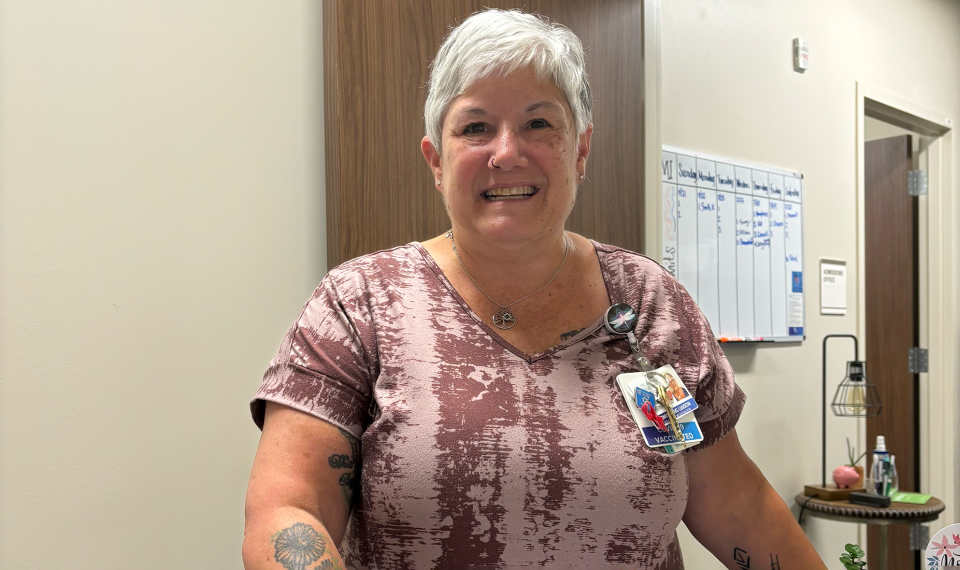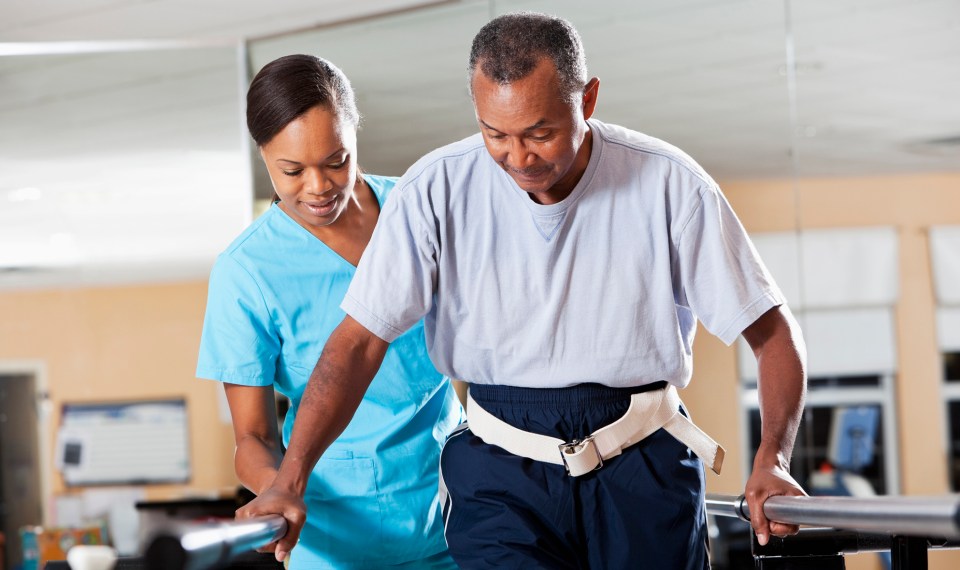Stroke occurs when blood flow to part of the brain is disrupted by blockage or a blood vessel in the brain ruptures. Stroke symptoms depend on the type, severity and location where the stroke occurred. Most are either a left-sided stroke or right-sided stroke. Wherever it occurs, a stroke is always an emergency because with every minute that passes, more brain cells are lost.
There are different types of stroke. Ischemic stroke, the most common, is due to a blockage caused by blood clots or a build-up of plaque in a vessel. Hemorrhagic stroke is caused by a leaky or ruptured artery in the brain. This type of stroke is usually due to an aneurysm (a bulge in the artery that can rupture or leak) or high blood pressure, which increases resistance in the arteries.
Recognizing Symptoms of Stroke
The American Stroke Association uses the acronym F.A.S.T. to educate the public on the warning signs of stroke and the importance of acting quickly. Regardless of whether the stroke happens on the right or left side, recognizing the symptoms and seeking immediate medical care is vital.
F – Facial drooping on one side of the face. This includes numbness or uneven smile.
A – Arm weakness. Weakness or numbness in one arm could be a sign of stroke. The
affected arm may also drift down when outstretched.
S – Speech difficulty. Slurring or garbled speech is a sign of stroke.
T – Time to call 911. Reaching a stroke center for immediate treatment can greatly reduce the effects of stroke.
The American Stroke Association lists the following as other signs and symptoms of stroke:
- Numbness in the arm, leg or face on one side of the body
- Confusion, trouble speaking or understanding speech
- Trouble seeing in one or both eyes
- Trouble walking including dizziness and loss of balance or coordination
- Severe headache with no known cause
While the above symptoms send a warning alert for stroke, the area of the brain where stroke occurred can determine the long-term effects. Although it may seem strange, a stroke on one side of the brain results in neurological complications on the opposite side of the body.
Download Our Free Life after Stroke Guide
Encompass Health is a national sponsor of the American Heart Association/American Stroke Association's Together to End Stroke. For more information on stroke prevention download our Life After Stroke guide for patients and caregivers.
Download NowRight-Sided Stroke
The largest portion of the brain is known as the cerebral cortex. It contains both a right and left hemisphere. Strokes that occur in the right hemisphere are referred to as right-sided strokes.
Effects that may be seen after a right-sided stroke include:
- Weakness or paralysis on the left side of the body
- Sensory issues, such as numbness or pain, on the left
- Vision problems including loss of vision in left field of each eye
- Problems with balance
- Hearing difficulties
- Interference with depth perception or simple directions (up, down, front, back)
- Dizziness or spinning sensation
- Memory problems
- Changes in behavior, such as impulsiveness, depression, flattened affect and inappropriate or childlike behavior
- Difficulty with spacial reasoning or awareness
- Loss of focus or shortened attention span
- Left neglect (an unawareness of the affected side—the left side of the body after a right-sided stroke), which leads to bumping into objects on that side, not comprehending body parts or objects on the left side, not seeing words on the left side of the page, etc.
Left-Sided Stroke
Stroke that occurs on the left side of the brain leads to neurological impairment on the right side of the body. Studies have indicated left-sided stroke may be more easily recognized than right-sided stroke.
Effects that might be seen with a Left-Sided Stroke include:
- Weakness or paralysis on right side of the body
- Speech or language difficulties including aphasia (inability to process, use or understand language)
- Behavioral changes, such as a slower more cautious approach
- Memory loss
- Visual disturbances including difficulty seeing objects or words in the right visual field
- Impaired reasoning skills, inability to do math, reduced analyzing skills
- Diminished left brain capacity resulting in difficulty reading, writing or learning
- Emotional distress
Risk Factors for Stroke
There are certain factors that place a person at higher risk for stroke. While some factors can be reduced with lifestyle changes, others cannot. Knowing the following risks is an important step in preventing stroke:
- Age. Although anyone can have a stroke, the risk increases with age.
- Family history. Stroke risk is increased in those with a family history of stroke.
- Race. African Americans are at greater stroke risk than Caucasians.
- Gender. More women have strokes than men and stroke is more deadly for women.
- Previous stroke. Stroke risk is greatly increased in those with previous stroke.
- TIAs. Transient ischemic attacks are known as “mini strokes” that produce the same symptoms as stroke without causing permanent damage. TIAs are warning signs and can increase the risk of stroke 10 times that of a person the same age and sex without them.
- Previous heart attack. The same plaque that builds up in the arteries and leads to heart attack can form in arteries in the brain and lead to stroke.
- Smoking. Current smokers are at 2.5 times the risk of stroke compared to never-smokers.
- Diabetes. Those with type 1 or 2 diabetes are at increased risk.
- Poor diet. Diets high in saturated fats, trans-fats and cholesterol can lead to obesity, high blood pressure and high blood cholesterol levels, increasing the risk for stroke.
- Physical inactivity. Being inactive increases the risk for stroke and other health conditions. Try to squeeze in 150 minutes of physical activity per week to reduce the risk.
- Carotid artery disease. Plaque build-up in the carotid arteries raises stroke risk.
- Sickle cell disease. SCD raises the risk for stroke, particularly in children.
- Geographical location. Those living in the “stroke belt” comprised of the southeastern states are more likely to suffer stroke.
- Alcohol or drug abuse. Both are associated with an increased stroke risk.
What Happens After a Stroke
Both right-sided and left-sided stroke victims require stroke rehabilitation, often in an inpatient rehabilitation setting. A quality rehabilitative program can help stroke patients regain strength and capability. The American Heart Association/American Stroke Association’s adult stroke rehabilitation guidelines state that, “Whenever possible, initial rehabilitation should take place in an inpatient rehabilitation facility rather than a nursing home.” As opposed to a skilled nursing facility, patients at an inpatient rehabilitation hospital will receive three hours of therapy, five days a week and will receive frequent physician visits and 24/7 nursing care.
Rehabilitation should be implemented as soon as the patient is medically stable. Rehabilitation services are based on specific needs but may include:
- Physical therapy to restore function and assist with skills such as walking and range of motion and to address other challenges including weakness and/or paralysis
- Occupational therapy with a focus on re-learning life skills including eating, dressing and self-care
- Speech therapy for communication, swallowing or cognitive issues. Patients and families may also learn alternate ways of communicating through pictures or gestures.
- Other needs including pain management and emotional support may also be part of rehabilitation.
The content of this site is for informational purposes only and should not be taken as professional medical advice. Always seek the advice of your physician or other qualified healthcare provider with any questions you may have regarding any medical conditions or treatments.



